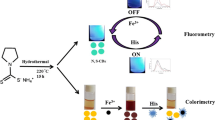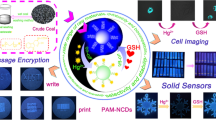Abstract
The authors describe a sensitive method for determination of glutathione (GSH) that is based on a thiol-triggered inner filter effect on the fluorescence of N-doped carbon dots (N-doped CDs). N-doped CDs with a quantum yield as high as 31% were prepared by a one-pot procedure, and 5,5′-dithiobis-(2-nitrobenzoic acid) was employed as a reagent for GSH recognition. The reaction product (5-thio-2-nitrobenzoic acid; TNB) acts as an absorber of the 410-nm light used to photo-excite the N-doped CDs. Hence, the fluorescence of N-doped CDs (peaking at 510 nm) is reduced with increasing concentrations of GSH. As little as 30 nM of GSH can be detected by this method. The approach was successfully applied to (a) food analysis, (b) an investigation of an oxidative stress model, and (c) to live cells imaging. The method does not require the surface of N-doped CDs to be chemically modified, and a linkage between receptor and fluorophore is not needed. In our perception, the method may become a viable tool for the detection and imaging of thiols.

Fluorescence sensing strategy for glutathione detection based on a thiol-triggered inner filter effect via new N-doped carbon dots and application to food analysis, oxidative stress study and cell imaging.






Similar content being viewed by others
References
Sies H (2013) Oxidative stress. Elsevier
Xu Y, Niu X, Zhang H, Xu L, Zhao S, Chen H, Chen X (2015) Switch-on fluorescence sensing of glutathione in food samples based on a graphitic carbon nitride quantum dot (g-CNQD)–Hg2+ Chemosensor. J Agric Food Chem 63(6):1747–1755
Guo Z, Park S, Yoon J, Shin I (2014) Recent progress in the development of near-infrared fluorescent probes for bioimaging applications. Chem Soc Rev 43(1):16–29
Tang Y, Lee D, Wang J, Li G, Yu J, Lin W, Yoon J (2015) Development of fluorescent probes based on protection–deprotection of the key functional groups for biological imaging. Chem Soc Rev 44(15):5003–5015
Jung H, Chen X, Kim J, Yoonet J (2013) Recent progress in luminescent and colorimetric chemosensors for detection of thiols. Chem Soc Rev 42(14):6019–6031
Biju V (2014) Chemical modifications and bioconjugate reactions of nanomaterials for sensing, imaging, drug delivery and therapy. Chem Soc Rev 43(3):744–764
Dong JX, Song XF, Shi Y, Gao ZF, Li BL, Li NB, Luo HQ (2016) A potential fluorescent probe: Maillard reaction product from glutathione and ascorbic acid for rapid and label-free dual detection of Hg2+ and biothiols. Biosens Bioelectron 81:473–479
Ju J, Zhang R, He S, Chen W (2014) Nitrogen-doped graphene quantum dots-based fluorescent probe for the sensitive turn-on detection of glutathione and its cellular imaging. RSC Adv 4(94):52583–52589
Tang W, Wang Y, Wang P, Di J, Yang J, Wu Y (2016) Synthesis of strongly fluorescent carbon quantum dots modified with polyamidoamine and a triethoxysilane as quenchable fluorescent probes for mercury(II). Microchim Acta 183(9):2571–2578
Wang B, Chen Y, Wu Y, Weng B, Liu Y, Li C (2016) Synthesis of nitrogen- and iron-containing carbon dots, and their application to colorimetric and fluorometric determination of dopamine. Microchim Acta 183(9):2491–2500
Li G, Kong W, Zhao M, Lu S, Gong P, Chen G, Xia L, Wang H, You J, Wu Y (2016) A fluorescence resonance energy transfer (FRET) based “turn-on” nanofluorescence sensor using a nitrogen-doped carbon dot-hexagonal cobalt oxyhydroxide nanosheet architecture and application to α-glucosidase inhibitor screening. Biosens Bioelectron 79:728–735
Liu B, Han S (2016) Determination of trace hydrogen sulfide by using the permanganate induced chemiluminescence of carbon dots. Microchim Acta 183(11):3087–3092
Cayuela A, Soriano ML, Carrillo-Carrion C, Valcarcel M (2016) Semiconductor and carbon-based fluorescent nanodots: the need for consistency. Chem Commun 52(7):1311–1326
Lim SY, Shen W, Gao Z (2015) Carbon quantum dots and their applications. Chem Soc Rev 44(1):362–381
Jiang X, Geng F, Wang Y, Liu J, Qu P, Xu M (2016) Fluorescence turn-on and colorimetric dual readout assay of glutathione over cysteine based on the fluorescence inner-filter effect of oxidized TMB on TMPyP. Biosens Bioelectron 81:268–273
Xia N, Zhou B, Huang N, Jiang M, Zhang J, Liu L (2016) Visual and fluorescent assays for selective detection of beta-amyloid oligomers based on the inner filter effect of gold nanoparticles on the fluorescence of CdTe quantum dots. Biosens Bioelectron 85:625–632
Chang H-C, Ho J-a A (2015) Gold Nanocluster-assisted fluorescent detection for hydrogen peroxide and cholesterol based on the inner filter effect of gold nanoparticles. Anal Chem 87(20):10362–10367
Kim H, Lee B-I, Byeon S-H (2015) The inner filter effect of Cr (VI) on Tb-doped layered rare earth hydroxychlorides: new fluorescent adsorbents for the simple detection of Cr (VI). Chem Commun 51(4):725–728
Li G, Fu H, Chen X, Gong P, Chen G, Xia L, Wang H, You J, Wu Y (2016) Facile and sensitive fluorescence sensing of alkaline phosphatase activity with Photoluminescent carbon dots based on inner filter effect. Anal Chem 88(5):2720–2726
Yan X, Li H, Han X, Su X (2015) A ratiometric fluorescent quantum dots based biosensor for organophosphorus pesticides detection by inner-filter effect. Biosens Bioelectron 74:277–283
Zhu S, Meng Q, Wang L, Zhang J, Song Y, Jin H, Zhang K, Sun H, Wang H, Yang B (2013) Highly photoluminescent carbon dots for multicolor patterning, sensors, and bioimaging. Angew Chem 125(14):4045–4049
Wang N, Wang Y, Guo T, Yang T, Chen M, Wang J (2016) Green preparation of carbon dots with papaya as carbon source for effective fluorescent sensing of iron (III) and Escherichia coli. Biosens Bioelectron 85:68–75
Li Z, Ni Y, Kokot S (2015) A new fluorescent nitrogen-doped carbon dot system modified by the fluorophore-labeled ssDNA for the analysis of 6-mercaptopurine and hg (II). Biosens Bioelectron 74:91–97
Lan M, Zhang J, Chui Y-S, Wang H, Yang Q, Zhu X, Wei H, Liu W, Ge J, Wang P (2015) A recyclable carbon nanoparticle-based fluorescent probe for highly selective and sensitive detection of mercapto biomolecules. J Mater Chem B 3(1):127–134
Riddles PW, Blakeley RL, Zerner B (1979) Ellman's reagent: 5, 5′-dithiobis (2-nitrobenzoic acid)-a reexamination. Anal Biochem 94(1):75–81
Rahman I, Kode A, Biswas SK (2006) Assay for quantitative determination of glutathione and glutathione disulfide levels using enzymatic recycling method. Nat Protoc 1(6):3159–3165
Guo Y, Yang L, Li W, Wang X, Shang Y, Li B (2016) Carbon dots doped with nitrogen and sulfur and loaded with copper (II) as a "turn-on" fluorescent probe for cystein, glutathione and homocysteine. Microchim Acta 183(4):1409–1416
Zhang X-L, Zheng C, Guo S-S, Li J, Yang H-H, Chen G (2014) Turn-on fluorescence sensor for intracellular imaging of glutathione using g-C3N4 Nanosheet–MnO2 sandwich Nanocomposite. Anal Chem 86:3426–3434
Han B, Yuan J, Wang E (2009) Sensitive and selective sensor for biothiols in the cell based on the recovered fluorescence of the CdTe quantum dots− hg (II) system. Anal Chem 81:5569–5573
Cai QY, Li J, Ge J, Zhang L, Hua Y, Li Z, Qu L (2015) A rapid fluorescence “switch-on” assay for glutathione detection by using carbon dots–MnO2 nanocomposites. Biosens Bioelectron 72:31–36
Zhang N, Qu F, Luo HQ, Li N (2013) Sensitive and selective detection of biothiols based on target-induced agglomeration of silver nanoclusters. Biosens Bioelectron 42:214–218
Rahman M, Hussain M, Asiri A (2016) A glutathione biosensor based on a glassy carbon electrode modified with CdO nanoparticle-decorated carbon nanotubes in a nafion matrix. Microchim Acta 183(12):3255–3263
Liu J, Bao C, Zhong X, Zhao C, Zhu L (2010) Highly selective detection of glutathione using a quantum-dot-based OFF–ON fluorescent probe. Chem Commun 46:2971–2973
Fu H, Ji Z, Chen X, Cheng A, Liu S, Gong P, Li G, Chen G, Sun Z, Zhao X, Cheng F, You J (2017) A versatile ratiometric nanosensing approach for sensitive and accurate detection of Hg2+ and biological thiols based on new fluorescent carbon quantum dots. Anal Bioanal Chem. doi:10.1007/s00216-017-0183-3
Saha A, Jana NR (2013) Detection of cellular glutathione and oxidized glutathione using magnetic–Plasmonic Nanocomposite-based “turn-off” surface enhanced Raman scattering. Anal Chem 85(19):9221–9228
Vedi M, Rasool M, Sabina EP (2014) Amelioration of bromobenzene hepatotoxicity by Withania somnifera pretreatment: role of mitochondrial oxidative stress. Toxicol Rep 1:629–638
Acknowledgements
This work was supported by The National Natural Science Foundation of China (No. 21677085, 21537001 and 81472986) and the Project funded by China Postdoctoral Science Foundation (No 2016 M590071).
Author information
Authors and Affiliations
Corresponding authors
Ethics declarations
The author(s) declare that they have no competing interests.
Electronic supplementary material
ESM 1
(DOCX 485 kb)
Rights and permissions
About this article
Cite this article
Wu, D., Li, G., Chen, X. et al. Fluorometric determination and imaging of glutathione based on a thiol-triggered inner filter effect on the fluorescence of carbon dots. Microchim Acta 184, 1923–1931 (2017). https://doi.org/10.1007/s00604-017-2187-2
Received:
Accepted:
Published:
Issue Date:
DOI: https://doi.org/10.1007/s00604-017-2187-2




